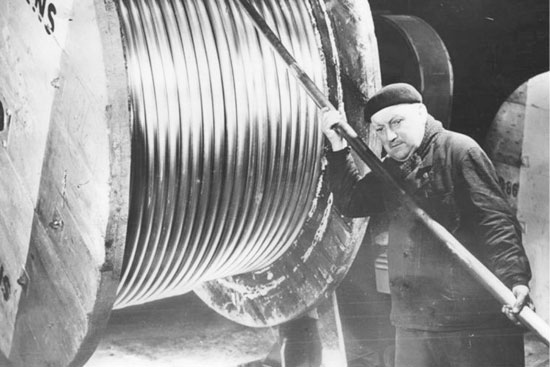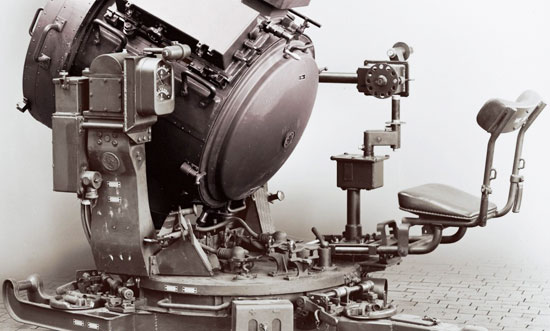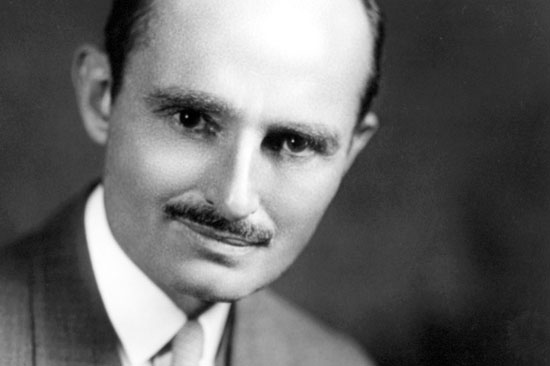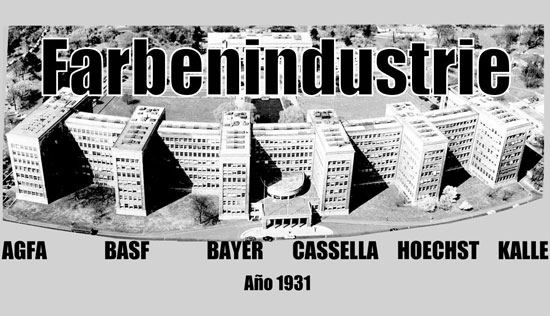Wall Street and the Nazi Cartels (2)
We present to you Chapter 1 from All Honorable Men: The Story of the Men on Both Sides of the Atlantic Who Successfully Thwarted Plans to Dismantle the Nazi Cartel System, by James Stewart Martin (kindle version, Forbidden Bookshelf 2016, first published by Little, Brown and Company, 1950).
Read the first part of the article

A Croatian who was forced to work for the Nazis in the Siemens cable factory in Berlin
We set up field offices in principal cities, the largest part of the staff being maintained at New York, where Robert Wohlforth headed some twenty or thirty lawyers and investigators. Our object was to test the possibilities of viewing the enemy through the chinks and loopholes of international business arrangements.
Once we knew which American companies had agreements with which Japanese or German companies we knew where to find engineers and technicians who had visited, and in some cases even had drawn the blueprints for, plants making synthetic rubber, synthetic gasoline, tetraethyl lead, precision ball bearings, and the like.
This kind of reporting became known as “bombing” work and we found ourselves quickly dubbed the “bottleneck boys.” Air Intelligence wanted to find out as much as possible about the industry in all areas where the Air Forces might be operating. They wanted to know the relative importance of different plants, partly to help plan the targets for bombing missions, and partly to help in figuring out what they had hit after the raid was over. We had neither the staff nor the facilities to make sweeping economic studies of German industries. But we could find out, from men who ought to know, which plants producing what materials were likely to be the “bottlenecks” in German production.
We had no way of knowing where all the coal mines or steel plants in Germany were; but we did find out that, by agreement among the biggest producers of precision antifriction bearings, practically all such bearings of any importance in Germany were made in only three factories grouped around the railway yards in Schweinfurt.
We could not locate all the gasoline refineries; but we did find out that there were only three plants equipped to make the tetraethyl lead which is necessary for high-octane aviation gasoline, and we found a man who could draw pictures of all three.
We did not know where to locate all of the mills producing brass for cartridge cases; but one of our men did find out that there were only two ways of making the special high-grade zinc that goes into this type of brass, both ways being the subject of patents, and he found blueprints and diagrams of all plants in Germany capable of making this zinc by consulting the files of two American companies.
While other agencies hired economists and technicians to lay out large studies of the German industrial economy, our men interviewed men from Du Pont, Standard Oil, International Telephone and Telegraph, Anaconda Copper, General Motors, General Electric, and investment bankers and other businessmen who had been to Germany on what turned out to be “bottleneck” deals.
As we worked on the search for bottlenecks in German production, we began to find a close relation between international business agreements for the restriction of production and the kinds of products which were especially critical in wartime. The trouble was that these international arrangements which pointed up the importance of certain commodities in the German economy had also resulted in restriction of production in the United States.
Arnold’s men found that one company, Rohm & Haas of Philadelphia, was not able itself to produce enough transparent plastic sheets for bomber noses. But because Rohm & Haas of Philadelphia had Du Pont under a special agreement, as part of a more complex and wider four-way arrangement involving Du Pont and two German firms, I.G. Farbenindustrie and Rohm & Haas of Darmstadt, Dupont was permitted to turn out only a limited quantity of the plastic sheets.
While government expediters were tearing their hair over slow deliveries, Du Pont was writing to Rohm & Haas of Philadelphia that they would have to tell the government about the agreement unless Rohm & Haas would lift the restriction.
We discovered even more spectacular complications, such as those in the three-way arrangement among the aircraft-equipment firms, Bendix of the United States, Siemens of Germany, and Zenith in England.

Under one of these arrangements the American firm in 1941 had stood by an agreement with the Siemens firm of Germany and forbade British Zenith to grant patent licenses so that the British Air Ministry could expand production of aircraft carburetors. Almost a year after Dunkerque, Zenith wrote to Bendix that:
The Ministry suggested they would prefer to manufacture the carburetors themselves and asked us to waive all our rights in this matter. We have told them plainly that “we are not prepared under any circumstances to agree to this or to alter one item of our contract with you”.
“You know that we have got to win the war if we are going to survive and it is because we know we shall win and survive that we are anxious that post-war business should not be complicated by departing from the conditions of the contract in the meantime and under the excuse of war conditions…”
As the war went on Senate committees probing production bottlenecks in the United States helped to compile and make public the records of a staggering number of similar arrangements, differing in detail but all having the same effect. They were widely denounced but principally on the ground that they represented “business as usual” during wartime. Editorials solemnly pronounced that all such arrangements should be “out for the duration.”
These business arrangements operated at focal points where it was possible to turn on and off the main valves in economic pipelines. It was not long before we found that the arrangement of valves and pipelines was a two-way affair.
Our elation at the discovery that practically all of Germany’s fine optical glass came from one factory, the Schott Works at Jena, was counteracted by the discovery that under the same working arrangement only one such factory of any importance existed in the United States. The pin point for bombing in Germany could be the blueprint for sabotage in the United States.
As if to add point to such thoughts about sabotage, during the summer of 1942 the Justice building in Washington played host to the trial of eight Nazi saboteurs who had been landed by submarine to blow up some of the key factories in the United States.
Morning and evening the black vans of the United States Marshal trundled the prisoners under our windows and all day long the drawn blinds on a row of windows two stories up and across the courtyard were a reminder that sabotage in the literal sense of the term was not just a theoretical possibility.
But sabotage in its literal sense was not the point. As our piecemeal reports stacked up a picture began to emerge of an enemy that did not need the services of trained, professional spies and saboteurs.
By agreement between German and American producers of magnesium — needed for aircraft — production in the United States before the war was limited to no more than 5000 tons per year. In contrast, Germany in 1939 alone used 13,500 tons and during the next five years consumed magnesium at the rate of 33,000 tons per year.
Here was a case where American “business is business” men had, knowingly or unknowingly, helped a German firm to close some valves over here, with far more effect than the eight saboteurs could ever have achieved even if they had been allowed to do their utmost.
Plants which have never been built are more dead than plants which have been bombed. A bombed plant may still live in its blueprints and in the trained labor force that had been operating it.
As the evidence piled up to show German success in negotiating restrictive arrangements, the contrast between the limited possibilities of cloak-and-dagger sabotage and the greater possibilities of safely negotiated business arrangements became more and more heavily underlined with each passing of the Black Marias under our windows.

Attorney General Francis Biddle, February 1935
Unfortunately, Francis Biddle and Thurman Arnold were still like stiff-legged fighting roosters with each other. Some of Biddle’s public remarks, including humorous references to the “bombing” work of Arnold and his boys, seemed to confirm our impression that the Attorney General considered what we were doing to be the product of a somewhat amusing mental aberration.
Finally, combined pressure from the War and Navy Departments and the War Production Board prevailed in suspending the enforcement of the antitrust laws for the duration of the war in all cases affecting industries considered important to the war effort.
All that was necessary to stop an investigation or the prosecution of a case was a certification from Robert P. Patterson, Undersecretary of War, James V. Forrestal, Undersecretary of the Navy, and John Lord O’Brian, General Counsel of the War Production Board, that any attempt to press the case would interfere with the war effort.
This signaled the end of Thurman Arnold’s great trust-busting drive. A short time later Arnold allowed himself to be kicked upstairs. He accepted an appointment as judge of the Court of Appeals for the District of Columbia.
With Arnold’s departure the Attorney General showed signs of more serious interest in the evidence of how the German program of economic warfare had been carried out. Biddle called for more and more thumbnail sketches of what we were discovering.
By the spring of 1944, the time came to add up the score. In three years, with a staff of less than sixty people, we had prepared thirty-six-hundred of these snapshots of German economic power in action; but the Attorney General wanted to know the conclusions of all these findings. We began to summarize our picture of an enemy that could survive a military defeat because it did not need or use military weapons.
This enemy did survive military defeat after World War I. We had in front of us the story of what lay behind the Ruhr occupation of 1923, the runaway German inflation, the Dawes and Young plans, the Dillon, Read and the Schroder bond issues, the growth of the Ruhr as the “industrial heart of Europe,” Germany’s strange obsession with heavy industry at the expense of consumer goods —“guns, not butter.”
As we summarized these findings, the Attorney General took more and more interest, became fascinated, began to speak in favor of doing something to prevent it all from happening again. He talked to President Roosevelt. In the fall of 1944 the President wanted some of these findings publicized, to pave the way for serious postwar policies to deal with the problem. He wrote his famous letter of September 6, 1944, to Secretary of State Hull: “… The history of the use of the I.G. Farben trust by the Nazis reads like a detective story. Defeat of the Nazi armies will have to be followed by the eradication of these weapons of economic warfare.”
We had started out to get a picture of our military enemy and had found a much bigger enemy, of a quite different sort from the popular picture of hobnailed Nazis with guns and tanks.
Late in the summer of 1944, Francis Biddle, the man who three years before had found nothing very important in the Sterling Products case, and who two years before had been amused by Thurman Arnold’s “bombardment” of Germany, told a Senate committee what he thought must be done during the occupation of Germany:
“… As we approach the occupation of Germany, we will have to decide what is to be done with the great German monopolistic firms. These are the firms that made the contracts in which we are interested. The period between the wars was only an armistice during which the firms of Germany conducted war against us. The British representative on the Inter-Allied Commission Supervising German Disarmament stated in a lecture in 1923:
‘We, in this country, flatter ourselves that the war ended on January 10, 1920; a future generation may yet describe the period in which we are living as an armistice during which the war was continued by other methods than rifle and howitzer, only to be resumed in all its carnal horror after the lapse of a few ambiguous years’.”
These firms in reality operated as departments of the German Government. They evaded and violated the peace treaties in order to build up Germany’s military strength. It was the theory of the German Government that operating under the guise of ordinary commercial arrangements, these firms could be used to weaken Europe and America so that when the military war was resumed, we would lose. Through the techniques of industrial penetration, they hoped to be able to cripple American production, to gain from us technical know-how, to conduct espionage upon us, and to establish centers of propaganda throughout the world.
The shadow of the Sterling case moved across Mr. Biddle’s account. Sterling had taken over the American Bayer Company after World War I and it was what Sterling and I.G. Farben had agreed to do with the business of American Bayer that had been the nub of the Sterling Products case in 1941. Mr. Biddle in 1944 told the Senate committee:
“I.G. Farbenindustrie is the principal combine which has been used by the German Government to attempt to restrict American production. It is the successor to the German dye trust which attempted prior to the last war to keep an independent American industry from developing. The president of the American Bayer Co., which was owned by the German dye trust, was told by his German superiors that his accomplishments in holding down American production before the last war could be compared to the work of an army leader who had succeeded in destroying 3 railroad trains of 40 cars containing 4 1/2 million pounds of explosives.”
After amplifying these conclusions with further facts he pounded home his point:
“We hope, as the years go by, we will not forget … not because we wish to have individual American companies condemned, but because these things should not be permitted to happen again. It is the system under which Germany was able to make these cartel agreements that must be broken up.
At the present time it is probably inaccurate to speak of separate combines or cartels in the German economy. They are all linked together — the ammunition makers, the potash industry, the machine trust, the oil industry, the electrical manufacturers, the steel trust, and the chemical companies. They exist as part of the Nazi government. We may expect, however, that when the government falls they will appear again as separate combines. The companies which were used as instruments to violate the peace treaties, to dominate industry in Europe, to support the Nazi war machine, and to restrict production here will then appear in the guise of ordinary commercial firms.”

The Attorney General put his finger on the gist of what we had learned when he underscored the fact that:
“The pattern of the activity of these firms was established before the Nazis came to power and during the early days of the German Republic. The German Government and the German people as a whole have never accepted the doctrines of economic liberalism which run through American history. The monopolistic firms of Germany have survived in that country through two wars and constitute a definite menace to the future peace of the world. As long as they survive in their present form it will be exceedingly difficult to develop independent industry in Europe outside of Germany.”
He called for action.
“I propose that we break the power of the German monopolistic firms. The purpose of such a program would not be to destroy German economic life in its entirety, but to put its industries into a form where they will no longer constitute a menace to the civilized world. I do not underestimate the difficulties involved in such a program.… Such a program cannot be worked out in any definite form on paper and at this distance from the field of operations. It will have to wait the period of supervision over these companies that should come during the occupation period. But this is a procedure which we did not follow after the last war. It will not be followed in this war unless we make up our minds to do it now and prepare for it … [We must] have some picture of what this complicated industrial interconnection is when, after Germany has been conquered, we sit down and say: ‘What will we do to break up this industrial domination?’ ”
yogaesoteric
July 5, 2019
Also available in:
 Français
Français
